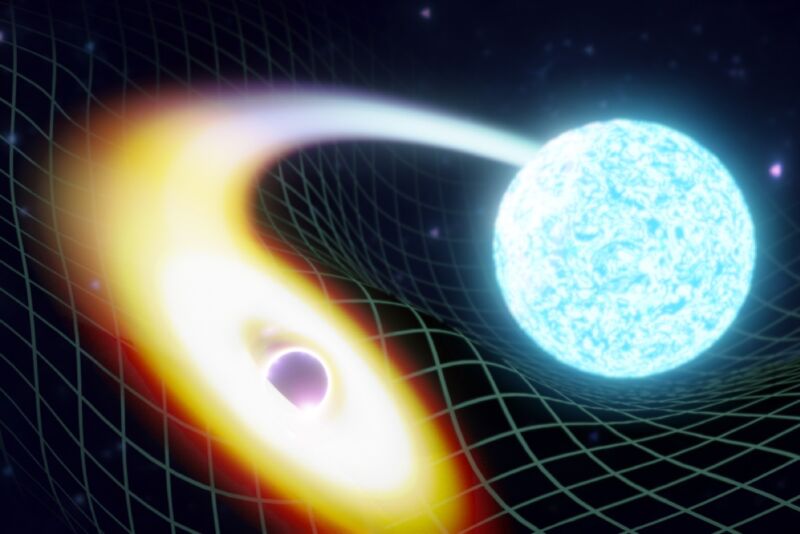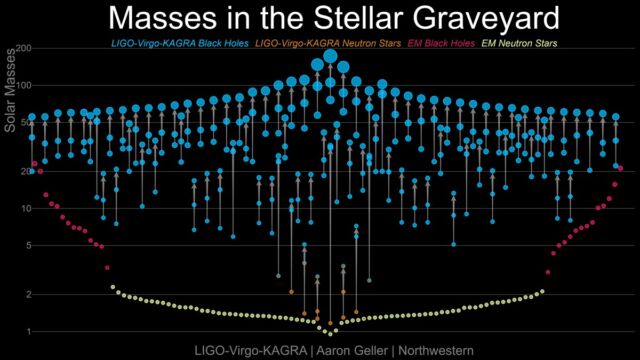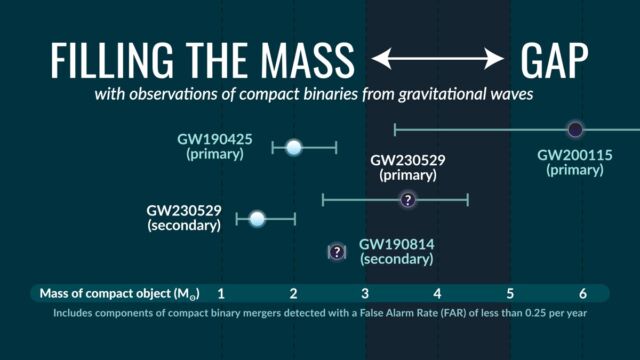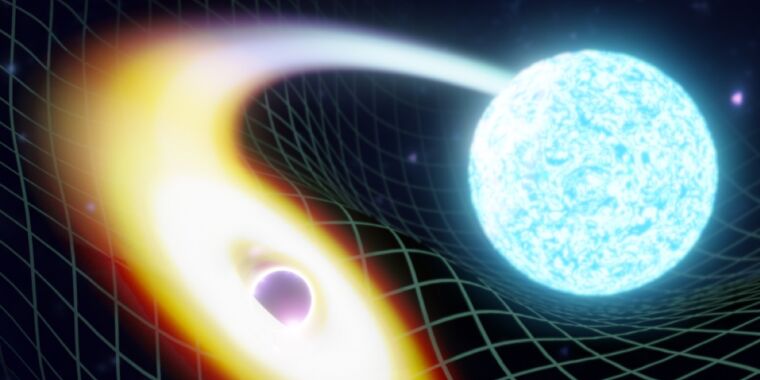Gravitational waves reveal “mystery object” merging with a neutron star
mind the gap —
The so-called “mass gap” might be less empty than physicists previously thought.

Enlarge / Artistic rendition of a black hole merging with a neutron star. LIGO/VIRGO/KAGRA detected a merger involving a neutron star and what might be a very light black hole falling within the “mass gap” range.
LIGO-India/ Soheb Mandhai
The LIGO/VIRGO/KAGRA collaboration searches the universe for gravitational waves produced by the mergers of black holes and neutron stars. It has now announced the detection of a signal indicating a merger between two compact objects, one of which has an unusual intermediate mass—heavier than a neutron star and lighter than a black hole. The collaboration provided specifics of their analysis of the merger and the “mystery object” in a draft manuscript posted to the physics arXiv, suggesting that the object might be a very low-mass black hole.
LIGO detects gravitational waves via laser interferometry, using high-powered lasers to measure tiny changes in the distance between two objects positioned kilometers apart. LIGO has detectors in Hanford, Washington state, and in Livingston, Louisiana. A third detector in Italy, Advanced VIRGO, came online in 2016. In Japan, KAGRA is the first gravitational-wave detector in Asia and the first to be built underground. Construction began on LIGO-India in 2021, and physicists expect it will turn on sometime after 2025.
To date, the collaboration has detected dozens of merger events since its first Nobel Prize-winning discovery. Early detected mergers involved either two black holes or two neutron stars, but in 2021, LIGO/VIRGO/KAGRA confirmed the detection of two separate “mixed” mergers between black holes and neutron stars.
Most objects involved in the mergers detected by the collaboration fall into two groups: stellar-mass black holes (ranging from a few solar masses to tens of solar masses) and supermassive black holes, like the one in the middle of our Milky Way galaxy (ranging from hundreds of thousands to billions of solar masses). The former are the result of massive stars dying in a core-collapse supernova, while the latter’s formation process remains something of a mystery. The range between the heaviest known neutron star and the lightest known black hole is known as the “mass gap” among scientists.
There have been gravitational wave hints of compact objects falling within the mass gap before. For instance, as reported previously, in 2019, LIGO/VIRGO picked up a gravitational wave signal from a black hole merger dubbed “GW190521,” that produced the most energetic signal detected thus far, showing up in the data as more of a “bang” than the usual “chirp.” Even weirder, the two black holes that merged were locked in an elliptical (rather than circular) orbit, and their axes of spin were tipped far more than usual compared to those orbits. And the new black hole resulting from the merger had an intermediate mass of 142 solar masses—smack in the middle of the mass gap.

Enlarge / Masses in the stellar graveyard.
xIGO-Virgo-KAGRA / Aaron Geller / Northwestern
That same year, the collaboration detected another signal, GW 190814, a compact binary merger involving a mystery object that also fell within the mass gap. With no corresponding electromagnetic signal to accompany the gravitational wave signal, astrophysicists were unable to determine whether that object was an unusually heavy neutron star or an especially light black hole. And now we have a new mystery object within the mass gap in a merger event dubbed “GW 230529.”
“While previous evidence for mass-gap objects has been reported both in gravitational and electromagnetic waves, this system is especially exciting because it’s the first gravitational-wave detection of a mass-gap object paired with a neutron star,” said co-author Sylvia Biscoveanu of Northwestern University. “The observation of this system has important implications for both theories of binary evolution and electromagnetic counterparts to compact-object mergers.”

Enlarge / See where this discovery falls within the mass gap.
Shanika Galaudage / Observatoire de la Côte d’Azur
LIGO/VIRGO/KAGRA started its fourth observing run last spring and soon picked up GW 230529’s signal. Scientists determined that one of the two merging objects had a mass between 1.2 to 2 times the mass of our sun—most likely a neutron star—while the other’s mass fell in the mass-gap range of 2.5 to 4.5 times the mass of our sun. As with GW 190814, there were no accompanying bursts of electromagnetic radiation, so the team wasn’t able to conclusively identify the nature of the more massive mystery object located some 650 million light-years from Earth, but they think it is probably a low-mass black hole. If so, the finding implies an increase in the expected rate of neutron star–black hole mergers with electromagnetic counterparts, per the authors.
“Before we started observing the universe in gravitational waves, the properties of compact objects like black holes and neutron stars were indirectly inferred from electromagnetic observations of systems in our Milky Way,” said co-author Michael Zevin, an astrophysicist at the Adler Planetarium. “The idea of a gap between neutron-star and black-hole masses, an idea that has been around for a quarter of a century, was driven by such electromagnetic observations. GW230529 is an exciting discovery because it hints at this ‘mass gap’ being less empty than astronomers previously thought, which has implications for the supernova explosions that form compact objects and for the potential light shows that ensue when a black hole rips apart a neutron star.”
arXiv, 2024. DOI: 10.48550/arXiv.2404.04248 (About DOIs).
Gravitational waves reveal “mystery object” merging with a neutron star Read More »
